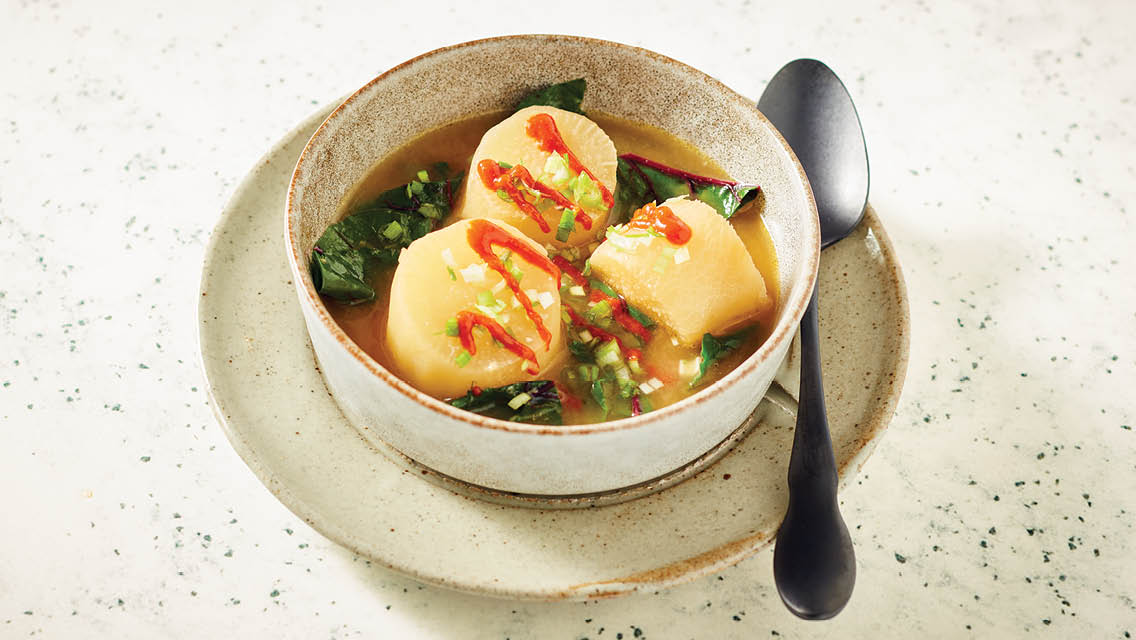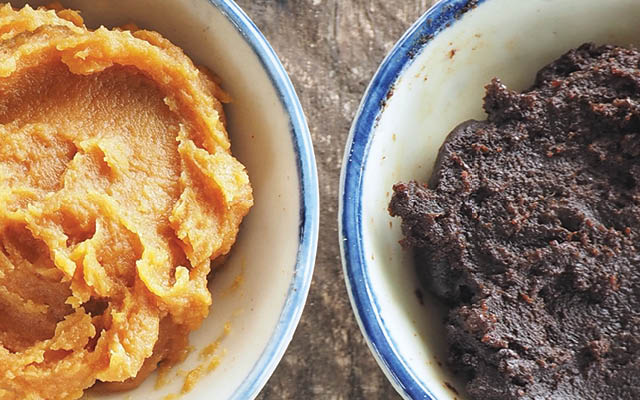In Japan, making miso — a basic cooking ingredient and condiment that’s aged like wine and cheese — is an art. But that doesn’t mean it’s complicated to prepare or eat. A good alternative to straight salt, miso is a snap to use in soups, sauces, spreads, salad dressings, dips and marinades.
Food Basics
Miso is a fermented soybean paste, or sometimes a rice or barley paste, that is similar in consistency to nut butters.
Savory, complex, rich and salty, miso is considered a umami flavor. (Umami is the fifth flavor — after sweet, salty, sour and bitter. Learn more about it in “Umami: The Secret Flavor”.) Miso comes in a variety of colors and variations: Red miso has a rich, savory, salty flavor; light yellow miso is less salty with a subtle tartness and smooth texture; and white miso features a more delicate flavor. You see this variety because some misos — in addition to their base of legumes or grains, and the mold, called koji, added to ferment them — can contain brown rice, white rice, barley, wheat, buckwheat or ginger. Miso’s flavors also become more complex over time; “bean paste” may be fermented for months or years.
You can find miso — which is sold refrigerated in a plastic or glass jar, a sealed bag, or in bulk — in Japanese and natural food markets and, increasingly, in conventional grocery stores.
Nutritional Know-How
One tablespoon of miso provides 2 grams of easy-to-digest protein and a rich array of probiotic (healthy) bacteria. Miso is also a good source of tryptophan, which helps the body synthesize that protein; manganese, an enzyme activator; zinc, critical to the immune system; and manganese and copper, which are essential for antioxidant functioning and energy production. It’s of particular value for vegetarians because it’s high in vitamin B12 and omega-3 fatty acids (primarily found in animal sources). Miso is high in sodium, though, so don’t go overboard with it as a seasoning.
Eat Up!
Miso is a delicate, living food, so take care to add it at the end of cooking. It’s good practice to remove your dish from heat and then stir in miso. If reheating, use low heat and bring to a light simmer. Avoid boiling.
- For a quick and easy miso broth, mix 2 cups of water with 2 tablespoons of miso. Adjust the amount according to the type of miso used and your taste preference. Add any desired ingredients.
- For miso mayonnaise, combine 1/3 cup of mayonnaise with 2 tablespoons of white miso. Use in salads or on sandwiches — anywhere you would use mayonnaise.
- Miso marinade or basting sauce is delicious with tofu, chicken, beef or salmon. Mix 2 tablespoons of red miso, 1 teaspoon of canola oil, 1/2 teaspoon of agave nectar, 1/2 teaspoon of grated ginger, 1/4 teaspoon of minced garlic and 2 tablespoons of water.
Kitchen Tricks
- If smaller containers are available at your grocery store, try buying a variety of miso flavors to test in different recipes.
- Miso paste will keep several months in the refrigerator. For miso in plastic bags, take care to remove excess air from the bag after opening, or move the miso to an airtight container. If purchasing in bulk, buy from vendors who practice safe food handling and be sure the miso is fresh.
Miso Soup With Soba Noodle Nest and Asian Vegetables
Makes eight servings
- 1/4 cup dried arame seaweed
- 6 cups water
- 1 1/2 cups diced soft tofu
- 1 tsp. minced garlic
- 1 tsp. minced fresh ginger
- 1/2 cup sliced and peeled carrot
- 2 green onions, chopped
- 1 cup chopped baby bok choy
- 1/2 cup sliced shiitake mushrooms
- 3 tbs. red miso paste
- 3 tbs. low-sodium soy sauce
- 2 cups cooked soba noodles
Directions
- In a small bowl, soak the arame in 1 cup of the water for about three minutes. Drain the arame and chop into 1/2-inch pieces.
- In a medium saucepot, bring the 6 cups of water to a low boil.
- Add the tofu, garlic, ginger and carrot. Reduce heat and simmer just until the carrot is starting to soften, about five minutes.
- Add the green onions, bok choy and mushroom and cook one minute.
- Turn the heat off and stir in the miso and soy sauce.
- Stir gently to dissolve the miso and let sit for two minutes.
- To serve, twirl 1/4-cup soba noodles into a nest. Place in serving bowl. Ladle 1 cup soup and vegetables into each bowl.
Per serving (1-cup): Calories 80; protein 6 g; total fat 2 g; saturated fat 0 g; carbohydrates 10 g; dietary fiber 1 g; cholesterol 0 mg; sodium 530 mg
Miso Orange Sauce
This versatile sauce is a great base for stir-fries, used as a marinade for chicken, beef, fish or tofu, or tossed with udon or soba noodles.
Makes three servings
- 3 cups unsweetened orange juice
- 1/4 cup fresh grated ginger root
- 2 tbs. white miso paste
- 1/2 tsp. toasted sesame oil
- 1 tbs. hoisin sauce
- 2 tbs. honey
Directions
- In a medium sauce pan, combine orange juice and ginger heat over medium-high heat and reduce orange juice by 1/3. Turn heat down to low.
- Whisk in miso paste, sesame oil, hoisin sauce and honey and cook over low heat for five minutes.
Per serving (1/2 cup): Calories 45; protein 0 g; total fat 0 g; saturated fat 0 g; carbohydrates 10 g; dietary fiber 0 g; cholesterol 0 mg; sodium 85 mg
Carrot-Miso Dressing
Makes 1 1/2 cups
- 3 carrots, peeled and chopped
- 1 2-inch piece of ginger
- 1 tbs. white miso paste
- 1 tsp. low sodium soy sauce
- 1/4 cup rice wine vinegar
- 1/4 cup orange juice
- 2 tbs. canola oil
Directions
- Combine the ingredients, except the oil, in a blender; pulse to combine.
- With the blender running slowing, add the oil to emulsify.
Per serving (1 oz): Calories 35; protein 0 g; total fat 2 g; saturated fat 0 g; carbohydrates 3 g; dietary fiber 0 g; cholesterol 0 g; sodium 140 mg
Recipes presented by Conscious Cuisine.




This Post Has 0 Comments